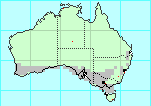Common Name:
Delete this section if there is no common name.
Identification:
Length: 176mm.
Coloring:
Note any distinguishing features.
male volant and mesopterous, female brachypterous
The wings of this insect are small and black, more or less obscurely
spotted with white; the costal area is green, irregularly marked with
black, but with the base of a lighter colour, and the black markings
more distinct; the head, prothorax and legs are light pinkish brown,
the latter very much dentated; the mesothorax, tegmina, abdomen and
leaflets, are blackish green; the former has small black tubercles;
the abdomen is spotted with black at the tip of each segment, which is
also somewhat dilated, while the leaflets are rather long and dentated.
(from
Gray, 1833)
seems to resemble
eucalypt twigs or stems. Males are slender and fully winged. The females
are much larger and have very short tegmina and very dark brown or
blackish hind wings and very long cerci.
Note parental placement of eggs.
Note appearance of eggs.
Note any common variations.
Habitat:
Note if the species arborial or terrestrial.
Canopy, mid, under, etc.
Note typical vegetation, e.g.
tropical rainforest, temperate rainforest,
grasslands,
alpine, etc.
Similar Species:
Ctenomorphodes tessulata is physically very similar, the best
differentiator is the shape of the eggs.
Rearing Notes:
Note if this species has ever been reared.
Note any suggestions for successful rearing.
For a stick insect with body length 176mm, to keep 2 adult females,
you need a cage at least 800mm high, 350mm deep and 350mm wide.
 Range:
Range:
quite common
in heath and woodland habitats from central New South Wales south
to Victoria.
NE coastal, SE coastal, S Gulfs, QLD, NSW, VIC, SA
Status:
References
-
Balderson, J., Rentz,
D.C.F. and Roach, A.M.E. (1998).
in
Houston, W.K.K. & Wells, A. (1998) (eds)
Zoological Catalogue of Australia.
Vol. 23.
Archaeognatha, Zygentoma, Blattodea, Isoptera, Mantodea, Dermaptera,
Phasmatodea, Embioptera, Zoraptera.
Melbourne: CSIRO Publishing, Australia (ISBN 0643 06035 9).
pp. 347 - 376.
-
Brock, P.D. (1999).
Review, Zoological Catalogue of Australia.
Bulletin of the Amateur Entomological Society,
58: 177-178.
-
Campbell, K. G., Hadlington, P., 1967.
The biology of the three species of phasmatids which occur in
plague numbers in forests of south eastern Australia.
Forestry Commission NSW Res. Note No. 20, 38 pp.
-
Clark, J.T. (1976).
The eggs of stick insects (Phasmida): a review with
descriptions of the eggs of eleven species.
Syst. Ent. 1: 95-105.
-
Hughes, L., 1996.
When an Insect is more like a Plant.
Nature Australia, 25(4): 30-38
-
Gray, G.R. (1833).
The Entomology of Australia in a Series of Monographs. Part 1.
The monograph of the genus Phasma.
London: Longman & Co. 28 pp. 8 pls
-
Gray, G.R. (1834).
Descriptions of several species of Australian Phasmata.
Transactions of the Royal Entomological Society of London,
i, 1 (November 7), pp. 45-46.
-
Gray, G.R. (1835).
‘Synopsis of the Species of Insects Belonging to
the Family of Phasmidae.’ 48pp.
(Longman, Rees, Orme, Brown, Green and Longman: London.)
-
Lea, A.M. (1902).
Notes on some remarkable Tasmanian invertebrates.
Pap. Proc. Royal Society of Tasmania, 1902: 81-82.
-
Readshaw, J. L. (1965).
A theory of Phasmatid outbreak release.
Australian Journal of Zoology, 13: 475-90
-
Rainbow, W.J. (1897).
Catalogue of the described Phasmidae of Australia.
Records of the Australian Museum, 3(2), 37-44.
[Note that he made a mistake re Extatosoma popa and E. tiaratum
according to
Gurney, A.B. (1947).
Notes on some remarkable Australasian walkingsticks, including a
synopsis of the Genus Extatosoma (Orthoptera: Phasmatidae).
Annals of the Entomological Society of America. 40(3): 373-396.
.]
-
Rentz, D.C.F (1996).
Grasshopper Country,
Chapter 16,
Phasmatodea: Leaf and Stick Insects,
pp. 244-257
-
Tepper, J.G.O. (1887).
Description of a supposed new species of Phasmidæ.
Transactions of the Royal Society of South Australia,
9 (1885-86): 112-113, pl. vi.
[Published March, 1887.]
[I already have the text of this one, but I need plate VI.]
-
Tepper, J.G.O. (1902).
List of the Described Genera and Species of the Australian and Polynesian
Phasmidæ (Spectre-Insects).
Transactions of the Royal Society of South Australia, 26: 278-287.
-
Vickery, V.R. (1983).
Catalogue of Australian stick insects (Phasmida,
Phasmatodea, Phasmatoptera, or Cheleutoptera). CSIRO
Australian Division of Entomology Technical Paper, No. 20, 15 pp.
- Search Google for
Ctenomorpha chronus,
or search Google Scholar for
Ctenomorpha chronus.
Synonyms:
-
Acrophylla chronus Kaup, 1871
-
Acrophylla scutigera Redtenbacher, 1908
-
Acrophylla tasmanensis Lea, 1902
-
Ctenomorpha marginipenne Gray, 1833
-
Ctenomorpha marginipennis Gray, 1833
-
Ctenomorpha oxyacantha Redtenbacher, 1908
-
Ctenomorpha phyllocerca Redtenbacher, 1908
-
Diura chronus Gray, 1833
-
Lopaphus macrotegmus Tepper, 1887
Copyright © 2000-2003
Peter Miller
This page was last changed 20-Sep-2006.
|

|

|



 Range:
Range: 
